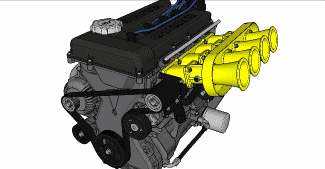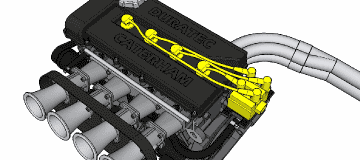Engine modifications
It’s worth noting at this point that it becomes exponentially more difficult and expensive to increase performance through engine mods, and although you might find it easy to add an extra five, ten maybe even fifteen percent, after that a huge amount of cash will only yield modest gains in power. Motorsport has always been a hobby for the privileged, so if you’re competing against millionaires it might be better to get into karting if you want to keep your house! An engine is actually a pretty simple beast, and achieving more power is a matter of increasing the volume of the raw materials, ensuring the bang is as efficient as possible and delivered at the right time, and ensuring waste gas is removes a quickly and efficiently as possible.
Air in (induction):
All cars are fundamentally compromised as they come out of the factory. Even performance car manufacturers are constrained by various emissions laws, cost saving measures, and warranty concerns which means engines almost never achieve their full potential at the dealership. Fitting a cheap air filter in the factory probably won’t affect sales, but this could save a car manufacturer huge amounts. As a result, helping the engine breathe better is one of the easiest ways of increasing performance, it’s cheap and you can do most things yourself with a bit of mechanical knowledge*. *Don’t modify any engine if you want to keep your warranty!
Air filter:
Air filters come in all sorts of different shapes and sizes and are there to prevent potentially damaging particles entering the engine. Smaller holes in the filter protect the engine better, but also restrict air flow. Clever design can improve the passage of air without compromising the engine, so at the very least you should replace the standard air filter with a higher performance version. Many filter upgrades are disposable so you’ll need to stock up on a few for when you next service your car, some are reusable but will need cleaning periodically – make sure you follow the instructions to get the most out of your purchase.
Pipes:
Fluid dynamics is an fascinating science, but also fairly inaccessible to most people. To sum up in a sentence, gas flows better in specially designed pipes. Think of the transition when pouring a bottle of water from the glug glug action to the nice fast flowing stream, this is what you need to achieve with the air going into the engine. Even with your nice new air filter fitted, you’ll still be limited by the inlet pipe design. In a Porsche you can be certain they’ve fitted the best possible turbulence free solution, but in bargain racers you can probably improve on the stock pipes. The major air filter companies such as K&N and Pipercross do a variety of ‘induction kits’ and if you dig around you can probably find one which is suitable for your car. These will consist of an air filter, and all the necessary pipes and fittings to get the air into the engine as fast and smoothly as possible.
Exhaust:
Now that the air is entering the engine in a nice smooth stream you’ll need to make sure it comes out the other end just as fast. Fitting the biggest exhaust pipe you can find may make your car sound great, but this can actually compromise the performance. Engines require a certain amount of back-pressure to function well, so it’s a matter of getting the balance right.
Exhaust manifold:
Exhaust exits each cylinder via small pipes, and depending on the configuration of your engine these combine into one, two or more larger versions. The resulting tangle of metal pipes can make it difficult for the gas to flow smoothly and freely, and a replacing this with performance exhaust manifold will aid the flow.
Exhaust pipes:
An exhaust pipe needs to be matched to an equally decent manifold for it to yield the largest gains in performance. This final part of the exhaust system is designed to reduce sound and pollution (if a catalytic converter is fitted) and have a variety of filters and chambers to help achieve this. ‘Cats’ remove poisonous chemicals such as nitrous oxide and sulphur dioxide, mufflers deaden the noise but both sap precious power. If your conscience allows it, removing both of these elements can provide a few additional horsepower. A good ‘straight through’ stainless steel pipe combined with an optimised manifold can be an easy and worthwhile investment.
Electronics:
ECU upgrade / remapping
One of the beautiful things about modern engines is the computerised control of almost every function, and even 20 year old engines will have some level of computer control over. ‘Computer’ is also a slightly misleading term, the hard work is done by relatively simple computer chips or Electronic Control Units (ECUs). ECUs have their preset parameters (or maps) hard wired into them by the factory and this is one of the ways that car manufacturers can change the character of an engine which is shared between many cars. Again, the mapping is the result of a compromise between emissions, economy, and performance and an ECU upgrade / remapping an existing ECU can be an easy performance gain. An ECU upgrade in a modern car can affect the following parameters:
- Spark timing relative to the piston position
- Electronic injection mixture
- Rev limit
- Valve timing
- Throttle progression
- Idle speed
Forced induction
How does a turbo work?
A turbocharger is essentially a high pressure pump which forces air into the engine, more air means a bigger bang and more power, simple! The pump is essentially a rotating fan, which is powered by the pressure of exhaust gas. This is a beautifully simple setup but has one major disadvantage – you need exhaust pressure before the turbo will spin up to a useful operating speed, and need to get the engine revs up before you see the increase in performance. This phenomenon is known as turbo-lag and means the power delivery can be much less linear that normally aspirated engines.
Considerations before fitting or tweaking a turbo
Turbochargers are an easy method of dramatically increasing the power of an engine, and if you already have a turbo fitted you may be able to extract even more power from it. Be warned though, many engines are built strong but some not so – getting turbo settings wrong will compromise your speed by way of a small explosion. A quick Google search will reveal whether your engine is suitable for a turbo, and if you’re lucky there may already be some after-market kits which have been tailored to your car.
Intercooler
Turbochargers produce a huge amount of heat due to the high speed of operation added to the fact they are powered by hot exhaust gas. The air which leaves the turbo will be at high pressure but also very hot and herein is the problem. Hot air expands which means there is less oxygen in any volume of hot air than the equivalent volume of cold air, less oxygen equals less bang which is lost power. An intercooler takes the hot air from the turbo and cools it in the same way as a car radiator, the air then contracts and you have more efficient combustion.
Find intercoolers at Partsgeek
Turbo modifications
If you’re lucky enough to have a turbo already fitted to your car, there are several things you can do to improve the performance. Most factory fitted turbos are set at a conservative level of boost by the manufacturer to reduce stress on the engine and provide increased durability. However, there are many engines which can withstand additional boost and operative reliably. Consult an expert to know if your engine is suitable for modification. The secret of increasing power via the turbo is to ensure the correct fuel to air ratios are maintained while increasing boost pressure – if you’re pumping in more air you need more fuel too. At first, it’s usually safest to increase the pressure by only a few PSI. The software on most modern vehicles will be able to adapt to this level of increase and deliver increased fuel to compensate. The methods involved with increasing boost pressure are varied, and you’ll almost certainly need a professional to do this for you, but the technique is outlined below. The basic boost pressure is maintained by the waste gate which is designed to open at set pressures. Adjusting the waste gate to open at higher pressures is probably the easiest method of increasing boost. If you’re looking for more power, you’ll need a specialist to tweak the injection settings.



Leave a Reply